Cloth hunting in Tanzania
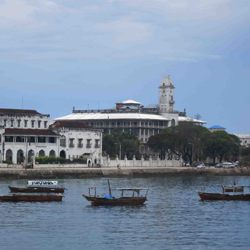
Stone Town, Zanzibar, from the ferry
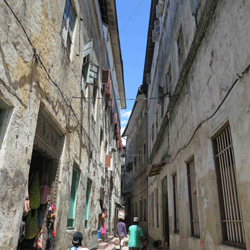
The heart of Stone Town
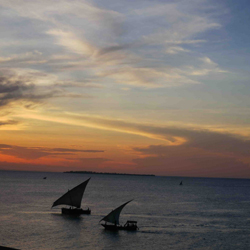
Indian Ocean at sunset
In the 19th century, cloth was big business in East Africa. From present-day Somalia down to Mozambique, the whole eastern half of the continent was experiencing an economic boom as it exported elephant ivory, slaves, aromatics and spices to Asia, Europe, and North America. With their newfound wealth, East African consumers largely sought to acquire foreign cloth and beads.
Responding to this demand, merchants of many nationalities imported millions of yards of handwoven and factory-made fabrics to East Africa, ordering qualities and patterns to please local consumers. Much of it was stolid cotton sheeting from the mills of Manchester and Massachusetts, but some of it was luxurious striped silks from India and the Arabian peninsula.
The great British explorers of East Africa -- Burton, Stanley, Livingstone -- had to literally pay their passage into the interior with this cloth. They purchased and carried tons of fabrics to pay for food, the rights to enter towns, to trade, and to negotiate with rulers.
Archival research has been an important part of my 2-year investigation into the historic textiles trades of eastern African, but studying the actual objects themselves has provdided some key breakthroughs.
In March, 2013, thanks to a ROM Department of World Culture Field Research Grant, I was able to make a first, exploratory research visit to Tanzania, the site of East Africa's major trading trails and emporium in the 19th century. I set my sights on the towns of Zanzibar, Bagamayo and Dar es Salaam.
A small island lying off the mainland of Tanzania, Zanzibar was the commerical seat of 19th century coastal East Africa, and nearly all imported cloth was funneled through it. Bagamayo, lying on the opposite shore, was usually the first stop for traders headed into interior Africa. There, they assembled their caravans, preparing the hundreds of bundles of cloth to be carried for trading.
Dar es Salaam is Tanzania's modern capital, a town invented only in the late 19th century, but an essential research stop as it is home to state archives and to Tanzania's largest university.
In the past, monsoon winds carried trading vessels to and from East Africa, squalls sinking more than one ship; today they can still wreak havoc, with monsoon rains bringing traffic to a near halt, and the infamous heat also bringing life to a standstill for a few hours in the day.

Contemporary monsoon hazards and solutions
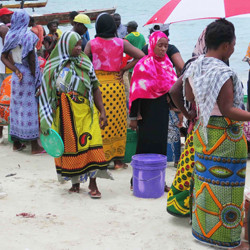
Bagamayo wrapper fashion
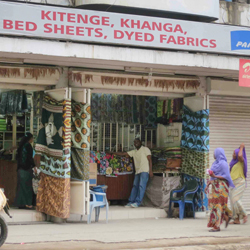
Cloth shop, Dar es Salaam
While waiting to obtain research clearance for Dar es Salaam and Zanzibar archives, I used my time to meet local colleagues, explore current day dress practices and cloth merchants and to situate myself within the historic geography of trade.
The most visible remants of Bagamayo's wealthy glory days of the 19th century are its carved wooden doors, status symbols of the well-to-do of the day. No longer a vital trade nexus, Bagamayo's old houses are often crumbling around the mighty doors.
The historic Stone Town of Zanzibar, on the other hand, a UNESCO heritage site, appears from the shores practically as it does in the illustrations of 19th travelogues.
Today, however, it is easly reached by a one-hour air conditioned ferry ride from the mainland, with cold drinks and Hollywood movies on offer. Yet Stone Town's sinuous, narrow streets remain vibrant lived-in spaces, with clamorous food markets and cloth shops. Dar es Salaam, meanwhile, is embracing the contemporary, the art deco shops of its Asian merchant quarter ceding at every turn to high-rise hotels.
Everywhere were visible legacies of the 19th century cloth trade: many women to this day dress in the printed wrappers known as khanga. These are vividly coloured rectangular wrappers, with bold graphic designs and proverbs in Swahili at the hem. The cloth represents a creative blending of African, Indian and European influences. Especially in Zanzibar, the streets and markets are a swirl of colourful khanga.
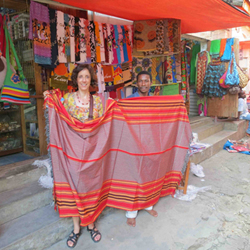
Cloth market, Zanzibar
But the striped silks I was seeking proved more elusive. Today they are little used in coastal Tanzania. However, I did find a few: industrial imitations for sale in the market. Once a part of elegant dress, now they are largely sold to tourists and used as interior furnishings. My search will continue.
